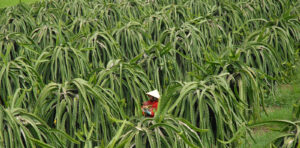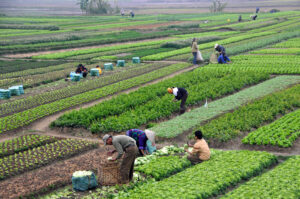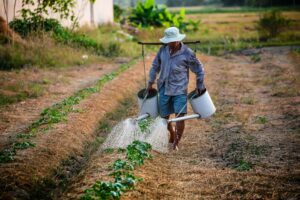The role of agriculture in Vietnam
The agriculture sector plays a crucial role in Vietnam’s economy and society. In Vietnam, the sector includes crop production, livestock, fisheries, and forestry. Vietnam’s tropical climate, fertile soil, abundant water supply and rich biodiversity means that after 40 years of Doi Moi economic reforms, the country has developed a diverse commercial agriculture sector to meet domestic and global demands.1 At present, a comprehensive restructuring program is being promoted as the sector stands at a crossroads of both opportunities and challenges.2

Dragon fruit picking. Photo by Lucas Jans. Licensed under CC BY-SA 2.0
In economic terms, the agriculture GDP accounts for about 13.96% of the total GDP in 2019.3 However, this number reflects a constant decrease from 38.06% in 1986,4 showing a deep transformation of Vietnam’s economy. In the period of 2001 – 2013, the agriculture sector growth rate was 3.57%/year, higher and less volatile than in other Asian countries.5 From a country threatened by hunger, Vietnam now ranks 2nd in Southeast Asia and 15th globally in agricultural exports.6 The export turnover rocketed from 4.2 billion USD in 20047 to 41.3 billion USD in 2019, accounting for 15.68% of total national exports.8 Vietnam’s leading export products are rice, coffee, pepper, tea, cashews, rubber, cassava, aquatic products, and furniture.9 The main export markets of Vietnam’s agricultural products are China, EU, the US, ASEAN, Japan, and South Korea.10
Figure 1: GDP composition by economic sector of Vietnam 1986-2019 (%). Adapted from Genenal Statistic Office of Vietnam
Figure 2: Agriculture growth rate of Vietnam and neighbour countries (%). Source: World Development Indicators.
In social terms, the sector helps to ensure national food security11 by supplying sufficient food for the population of 96.48 million people.12 This is primarily through rice, which is the dominant food staple.13 Vietnam’s per capita food availability14 ranks among the top for middle-income countries.15
Figure 3: Vietnam national rice balance 1986-2010 (million tons). Source: World Bank
Figure 4: Daily food availability in selected Asian countries, 1961-2009 and 2009 – 2030 (projected). Unit: Kcal/person/day. Logarithmic estimate. Source: World Bank
The agriculture sector has historically been a major employer of Vietnamese people, employing 65% of the national workforce in 2000. However, in recent years this has dropped significantly, to 47.4% in 2012 and 39.4% % in 2019.16 Yet almost 50% of rural households in 2016 reported that their main source of income continues to be from agriculture, although this reliance is a decrease from 68% in 2006.17 Agriculture transformation contributed to poverty reduction in rural areas, reflected by increased income from non-crop cultivation, especially among ethnic minorities.18
The agriculture sector also accounts for a large proportion of natural resource use, such as land, water, forest, and other raw materials, much of which has otherwise been reallocated to urban and industry development.
Figure 5: Agriculture’s contribution to rural household income by ethnicity and region (%). Source: General Statistic Office of Vietnam

Vegetable field. Photo by Dennis Jarvis. Licensed under CC BY-SA 2.0
As a result, the agriculture sector has contributed to the socio-political stability, industrialization and modernization of Vietnam in the past 40 years, especially by acting as a safety net for the whole economy during times of crisis.19 The agricultural sector continues to perform this function during the 2020 COVID-19 pandemic, including through the distribution of food to the poor and unemployed,20 stabilisation of consumer prices, provision of alternative employment, and generation of export revenues.21 ADB projections indicate that Vietnam’s economy will continue to be the fastest growing in Asia despite the impacts of COVID-19.22 However, Vietnam’s most vulnerable, particularly migrant, informal workers and women,23 as well as ethnic minorities living in rural areas will be the hardest-hit by this pandemic. The government has developed a COVID-19 support package for vulnerable populations,24 but only those who are recognized by the government.

A farmer is watering plants. Photo is licensed under Creative Commons CC0.
The impact of current agricultural policy
Growth in the agricultural sector so far has been attached to a strategy of pushing agricultural growth through expanding in area, increasing numbers of crops, exploiting natural resources (land, water, forests), and relying heavily on labour and chemical factors of production (fertilizers and pesticides) without much concern over sustainability.25
Figure 6: Consumption of NPK fertilizer per hectare of arable land in selected Asian countries. Source: World Development Indicators.
Consequently, growth is slowing down, with quantity-based growth dominating over quality and value addition.26 Agriculture GDP growth decreased from 4.17% in 2002 to 4.01% in 2011; to 2.72% in 2012 and to 2.67% in 2013.27 Improvements on the poverty rate have stopped short, a new trend after many years of 2% reduction in poverty on average annually.
Benefits from poverty reduction are no longer being seen, and existing benefits primarily reach the Kinh majority, and those in urban and plains areas. Inequalities between different regions have been growing; poverty is increasingly concentrated in communities of ethnic minorities and landless people.28 In addition, economic success has come at an environmental cost, such as deforestation, depletion of natural resources and biodiversity, land degradation and water pollution.29 Such consequences seriously challenge Vietnam’s ability to achieve the SDGs by 2030.30
Figure 7: Vietnam Agro -Enviornmental Hotpots. Source: World Bank
Opportunities and challenges
The agriculture sector currently faces a number of new opportunities and challenges. While international integration and changing consumption patterns has opened up domestic, regional and international markets, there are increasing concerns over ethical food production,31 and food safety and origin.32 Yet there is a continuing drive to push development through the agri-industry sector, and technological innovation is seen as a tremendous driving force to counter limitations in natural resources, increases in labour costs, and low capital investment.33 Climate change and related environmental issues are a continuing challenge, with adverse impacts on production requiring suitable adjustment and adaptation.34 Being well aware of the situation, the Ministry of Agriculture and Rural Development (MARD) has been integrating climate change mitigation and adaption into all of its plans and strategies, including Program Framework for Climate Change Adaptation in the period 2008-2020, Climate change Action plan for Agriculture and Rural development in the period 2016-2020, Green growth Action plan for Agriculture and Rural Development to 2020, and most recently MARD’s Implementation action plan for Paris Agreement on climate change in the period 2021-2030.
In addition, the Government of Vietnam introduced the Agricultural Restructuring Program (ARP) in 201335 and an updated plan 2017,36 aiming to promote economically, socially, and environmentally sustainable development. The ARP promotes the transition from quantity-oriented production to demand driven and high value-added agribusiness at low environmental cost. In other words, the program aims for the sector to “gain more from less”,37 referring to gaining economic value but requiring less natural and human capital. This will require greater efficiency in land and water use, a shift toward more knowledge- and skill-based agricultural practices, better realized economies of scale and scope within value chains, and marked shifts in the function and performance of the government. This transition needs broader economic reforms including changes in macro- and sectoral policies (e.g. land use) and institutions (e.g operation of SOEs, banks, and institutions associated with science and technology), multi-stakeholder inclusion and government decentralization and coordination.38
References
- 1. World Bank, Ministry of Planning and Investment of Vietnam. 2016. “Vietnam 2035: Toward Prosperity, Creativity, Equity and Democracy”. Washington, DC: World Bank. Accessed March, 2020.
- 2. World Bank. 2016. “Transforming Vietnamese Agriculture: Gaining More from Less”. Vietnam Development Report. Washington, D.C. World Bank. Accessed March, 2020.
- 3. General Statistics Office of Vietnam. “Social and economic situation in 2019”. Accessed March, 2020.
- 4. The Global Economy. “Vietnam GDP share of Agriculture”. Accessed March, 2020.
- 5. World Bank. 2016. “Transforming Vietnamese Agriculture: Gaining More from Less”. Vietnam Development Report. Washington, D.C. World Bank. Accessed March, 2020.
- 6. World Bank. 2016. “Transforming Vietnamese Agriculture: Gaining More from Less”. Vietnam Development Report. Washington, D.C. World Bank. Accessed March, 2020.
- 7. Finance news – Ministry of Finane (web portal). 2005. “Agriculture and forestry export in 2005 is targeted to reach 4.5 billion USD”. Accessed May, 2020.
- 8. General Statistics Office of Vietnam. “Social and economic situation in 2019”. Accessed March, 2020.
- 9. Ministry of Industry and Trade. 2019. “Vietnam Export and Import Report 2018”. Hanoi. Accessed March, 2020.
- 10. Ministry of Industry and Trade. 2019. “Vietnam Export and Import Report 2018”. Hanoi. Accessed March, 2020.
- 11. World Bank. 2016. “Transforming Vietnamese Agriculture: Gaining More from Less”. Vietnam Development Report. Washington, D.C. World Bank. Accessed March, 2020.
- 12. General Statistics Office of Vietnam. “Social and economic situation in 2019”. Accessed March, 2020.
- 13. World Bank. 2012. “Vietnam Rice, Farmers and Rural Development: From Successful Growth to Sustainable Prosperity”. World Bank: Hanoi, Vietnam, 2012. Accessed March, 2020.
- 14. Food availability is when all people have sufficient quantities of food available on a consistent basis. Food availability is determined by food production and food trade (FAO, 2008).
- 15. World Bank. 2016. “Transforming Vietnamese Agriculture: Gaining More from Less”. Vietnam Development Report. Washington, D.C. World Bank. Accessed March, 2020.
- 16. World Bank data. “Employment in agriculture (% of total employment), modelled ILO estimate for Vietnam”. Accessed March, 2020.
- 17. Cunningham, Wendy; Pimhidzai, Obert. 2018. “Vietnam’s Future Jobs : Leveraging Mega-Trends for Greater Prosperity (Vol. 4) : Main Report (English)”. Washington, D.C. : World Bank Group. Accessed March, 2020.
- 18. Pimhidzai, Obert. 2018. “Climbing the ladder: poverty reduction and shared prosperity in Vietnam”. Washington, D.C.: World Bank Group. Accessed April, 2020.
- 19. The Voice of Vietnam (web portal). 2012. “Affirming the role of agriculture sector in Vietnam’s economy”. Accessed March, 2020.
- 20. CNN. 2020. “Rice ATMs’ provide free rice for people out of work in Vietnam due to the coronavirus crisis”. Accessed April, 2020.
- 21. Viet Nam News. 2020. “Ministry targets no drop in exports this year despite COVID-19”. Accessed April, 2020.
- 22. Asian Development Bank. 2020. “Viet Nam’s Economy to Remain One of the Fastest Growing in Asia Despite Sharp Slowdown Due to COVID-19”. Accessed April, 2020.
- 23. International Labour Organisation. 2020. “Viet Nam can well address labour market challenges”. Accessed April, 2020.
- 24. VNExpress. 2020. “Vietnam approves $2.6 billion support package for Covid-19 crisis victims”. Accessed April, 2020.
- 25. OECD. 2015. “Agriculture policy in Vietnam 2015”. OECD Food and Agricultural Reviews, OECD Publishing, Paris. Accessed March, 2020.
- 26. World Bank, Ministry of Planning and Investment of Vietnam. 2016. “Vietnam 2035: Toward Prosperity, Creativity, Equity and Democracy”. Washington, DC: World Bank. Accessed March, 2020.
- 27. World Bank. 2016. “Transforming Vietnamese Agriculture: Gaining More from Less”. Vietnam Development Report. Washington, D.C. World Bank. Accessed March, 2020.
- 28. Vietnam Ministry of Planning and Investment. 2015. “Country Report: 15 Years Achieving the Viet Nam Millennium Development Goals”. Hanoi. Accessed March, 2020.
- 29. Asian Development Bank. 2013. “Viet Nam: Environment and climate change assessment”. Mandaluyong City, Philippines: Asian Development Bank. Accessed March, 2020.
- 30. Anja Baum. 2020. “Vietnam’s Development Success Story and the Unfinished SDG Agenda”. IMF working paper, 2020. Accessed March, 2020.
- 31. Cameron A, Pham T H, Atherton J, Nguyen D H, Nguyen T P, Tran S T, Nguyen T N, Trinh H Y & Hajkowicz S. 2019. “Vietnam’s future digital economy – Towards 2030 and 2045”. CSIRO, Brisbane. Accessed March, 2020.
- 32. PricewaterhouseCoopers. 2017. “Spotlight on Vietnam – The leading emerging market”. PwC: Ho Chi Minh City, Vietnam. Accessed March, 2020.
- 33. World Bank, Ministry of Planning and Investment of Vietnam. 2016. “Vietnam 2035: Toward Prosperity, Creativity, Equity and Democracy”. Washington, DC: World Bank. Accessed March, 2020.
- 34. Schirmbeck S. 2017. “Vietnam’s environmental policies at a crossroads: Salinated rice fields, hunted-out national parks, and eroding beaches – and what we can do about it”. Friedrich Ebert Stiftung: Hanoi, Vietnam. Accessed March, 2020.
- 35. The Socialist Republic of Vietnam. 2013. “Decision 899/2013/QD-TTg approving the programme for Agricultural restructuring towards raising added values and sustainable development”. Accessed March, 2020.
- 36. The Socialist Republic of Vietnam. 2017. “Decision 1819/2017/QD-TTg approving the agriculture restructuring plan 2017 – 2020”. Accessed March, 2020.
- 37. World Bank. 2016. “Transforming Vietnamese Agriculture: Gaining More from Less”. Vietnam Development Report. Washington, D.C. World Bank. Accessed March, 2020.
- 38. World Bank, Ministry of Planning and Investment of Vietnam. 2016. “Vietnam 2035: Toward Prosperity, Creativity, Equity and Democracy”. Washington, DC: World Bank. Accessed March, 2020.


